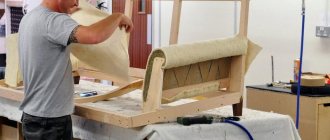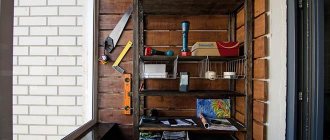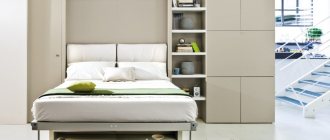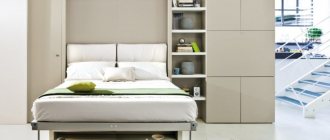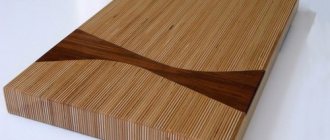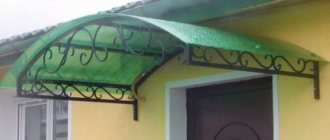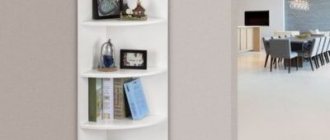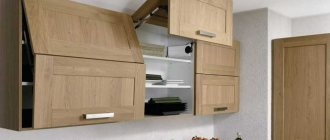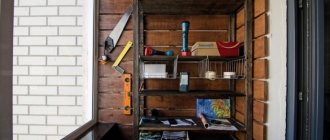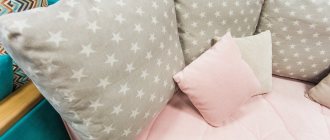Reupholstering a sofa is a rather difficult process, but sometimes necessary. Any upholstered furniture takes on a very unsightly appearance over time, and the sofa is no exception. Various damage and irremovable stains may appear on the upholstery, which makes it necessary to replace it.
Of course, with such a problem, you can contact a workshop and specialists will reupholster the sofa, but you will have to pay an impressive amount of money for some people. But you can take the opportunity to save money and reupholster your upholstered furniture yourself. This is what our article today will be about.
Do-it-yourself sofa reupholstery
When is it necessary to reupholster a sofa?
Damage to upholstered furniture can vary significantly, so it is recommended to first assess the severity of the problem.
Updating the sofa needs to be done in the following cases:
- The upholstery fabric has lost its original appearance. Typically, such damage is associated with the natural wear and tear process of any fabric. In addition, the material can be damaged by pets. This is the simplest type of damage; in this case, a standard replacement of the covers will be sufficient.
The sofa has lost its appearance - Presence of depressions in the seat. This problem is associated with wear and tear on the soft part of the sofa. In this case, you will need to replace the foam rubber and other layers. If there is a spring structure, it is sometimes necessary to replace or repair the spring units. At the same time, the upholstery does not always need to be removed (if it looks decent), but it will have to be washed.
- The bottom of the sofa is sinking. This happens when there is excessive load on the springs, which quickly penetrate a thin layer of fiberboard. In this case, the structure will have to be disassembled and the bottom replaced (it is better to use plywood).
- Frame deformation. The presence of various cracks in the base of the structure is a more serious problem. In this case, you will need to completely disassemble the sofa and replace the damaged bars.
Reupholstering furniture is much more profitable than buying a new product. In addition, thanks to reupholstery, you can change your sofa beyond recognition by choosing a different color and texture of the covering.
Video - How to get rid of a hole in the sofa
Damage, types of repair
Damage to upholstered furniture is most often caused by prolonged or careless use. The fabric worn to a shine on the seat, armrests, back will fit perfectly into loft, vintage, art-believe interiors, but will be out of place in classic, minimalism, modern and most others.
Upholstery material is damaged if it is not properly cared for, by children who spill drinks, who draw with felt-tip pens, as well as by pets who like to chew corners or sharpen their claws on the armrest. Fading, rubbing to holes, stains that cannot be removed, fabric tears also require replacement of all or part of the upholstery.
Dented surfaces worsen the appearance and reduce performance properties. In this case, it is necessary to replace foam rubber, padding polyester, and in some cases, spring blocks. Large dips at the bottom occur due to high loads - the springs simply pierce the bottom, they need to be removed by replacing the damaged bottom with plywood or fiberboard. It is permissible to completely remove the springs, replacing them with a thick layer of foam rubber, furniture silicone, and other fillers.
Violation of the integrity of the frame makes it impossible to use the sofa for its intended purpose. Defects requiring repair include weakening of tenon joints, breaking off of sidewalls, the appearance of visible gaps, and general loosening of the structure. If wooden parts are severely damaged by insects, fungus, or mold, they must be replaced. If transported incorrectly, it is also easy to break the sofa.
A separate category of damage is chips, cracks, and other problems in the places where the closing and opening mechanisms are attached. Most often this applies to “Eurobook” type models, wardrobe sofas, and kitchen structures with drawers. Often the frame is so damaged that most of the parts will have to be replaced, that is, completely disassemble the old sofa and assemble a new one.
When making a decision to repair, you should calculate the cost of repairs and materials - if restoration, even independent, costs about the same as buying a new product, then it is not practical.
Types of sofa designs
Table 1. Seat and backrest manufacturing options.
| Option | Description |
| Without springs | On dense furniture foam rubber or latex foam. The second method is considered more practical and convenient, but has a high cost. |
| With springs | With standard springs assembled into a single unit, or with snake springs that support a soft base. These types of structures are the most common. |
The sofa may have a multi-layer structure, which must be studied before reupholstering.
It should be borne in mind that there are other additional layers. For example, modern designs are supplemented with layers of felt and synthetic padding, while older models were stuffed with horsehair, burlap and similar materials.
For the inner layer you need to purchase padding polyester in a roll.
Standard version of the sofa with a zigzag block
In order to properly reupholster a sofa, you need to know the exact location of the layers of material. In the standard version of the product, the following sequence occurs:
- Plywood frame or wooden slats. Of course, the first option is more durable, but has a high cost, so pine slats or bars are often used to make the frame. They are fixed to each other through grooves using glue. Sometimes, for greater reliability, the structure is reinforced with metal corners. sofa frame
- The base is under the block (spring). For such purposes, special planks are used - lamellas, plywood and fiberboard. The first option is the most expensive, so craftsmen, trying to save money, use plastic strips, which quickly crack. Another option for reducing the cost of a sofa is to install slats with large gaps, as a result of which the structure quickly loses its elasticity and the slats sag greatly.
- Spring block. The design can be with independent or dependent springs. In the second case, the sitting will be more comfortable; it is also called massage.
- Felt or any thick fabric. The presence of such a layer prevents deformation of the foam rubber by springs.
- Furniture foam rubber. It is important that in addition to density, such a material is durable. This means that after any load it should recover quickly. In case of replacement, thicker material can be used, but this is not possible with a folding design. Durable furniture foam
- Sintepon. This soft lining prevents the foam from rubbing with fabric. To prevent it from forming into lumps during use, it is usually fixed to the previous layer with glue.
- Fabric covering. It can be anything, but when choosing a new one, choose dense materials that will not crumble or deform during processing.
Important point! Some craftsmen prefer to line them with a double layer of padding polyester for greater softness.
Constriction technology
Repair of upholstered furniture is a process consisting of several successive stages.
Brief step-by-step instructions for restoration:
- Carrying out measurements and calculations, drawing up a diagram.
- Purchasing everything you need.
- Disassembly.
- Removing old upholstery.
- Removing the filler.
- Assessing the condition of parts, carrying out restoration work
- Pattern and preparation of new upholstery.
- Sofa reupholstery.
- Product assembly.
If each stage is performed correctly, you can count on a good result.
Disassembly
To repair a sofa, it must first be disassembled into its component parts. The scope of dismantling is determined by the design of the product and the defects identified during it. Before starting work, you need to prepare a plastic container for storing fasteners.
Disassembly is carried out in the following sequence:
- Extending the movable parts and removing the removable fragments, moving them to the side.
- Side back compartment. They are held on by rigidly fixed bolts inserted into the frame.
- Loosening and unscrewing the nuts connecting the parts to each other.
- Disconnecting modules from each other.
- Removing brackets and rollers that are attached to the upholstery material.
The scope of dismantling is determined by the design of the furniture. The end result is access to all the places where the fabric is attached to the frame.
Removing old upholstery
The material is fixed to the wood with thin steel staples. Nails can be used in critical places. It is convenient to pry the staples with an awl or a flat-head screwdriver, after which they need to be grabbed with pliers or wire cutters and removed from the base.
The upholstery must be removed carefully if you plan to reuse it. This decision is made in cases where it is necessary to replace sagging filler or remove dirt from an entire cover.
Once access to the internal contents of the product has been opened, you need to assess its condition. If a spring sofa is being reupholstered, you should check the degree of wear of the metal. Broken fragments are replaced with whole ones, and rusty ones are cleaned and lubricated.
Then you should evaluate the condition of the solid wood and plywood. Minor damage can be repaired using self-tapping screws, patches and ties. If the load-bearing elements cannot be restored, they are replaced. It is advisable to treat the tree with antiseptic and hydrophobic agents to prevent the development of fungus and mold.
Pattern and preparation of new upholstery
Patterns are made based on measurements of the fragments that make up the product. After the measurements, a figure is drawn, along the edges of which the height of the padding and 4-5 cm are added to the folds. This is done when the material is purchased in advance, before dismantling.
The final stage is to give the workpieces volume and make corners. This is done on a sewing machine, after which the excess material is cut off with scissors. This will make the edges of the furniture look sharper and neater.
Reupholstery of individual parts of the product
The sequence of fastening the fabric does not matter, but it is advisable to start with the most complex parts so as not to work with them in a state of fatigue and weakened attention.
The reupholstery of the sofa backs, seats and spacers is carried out in the following sequence:
- A dense material such as a blanket, felt or tarpaulin is secured over the springs - it will protect the soft part from sharp parts and corrosion.
- The filler is glued. If thick foam rubber is not available for sale, you can use several layers of slabs 2-5 cm thick.
- The patterns are laid face down on the floor. The bases covered with foam rubber are placed and leveled on top.
- In the middle of the wide side, the fabric is stretched and nailed to the wood with a staple. The operation is repeated on the remaining sides of the part. Then nailing is carried out from the center to the edges at intervals of 4-5 cm.
- The corners are formed in several steps from the sharp part to the sides. It is better to cut off excess matter.
The final step is to cover the bottoms of the fragments and the attachment lines with the frame with camouflage fabric. It is fixed with staples in increments of 8-10 cm.
Assembly
The product is assembled in the reverse order of the dismantling performed at the beginning of the work:
- The corner jumper is assembled and installed in the place where it will be finally placed.
- The previously removed folding, fixing or rolling mechanisms are screwed onto the fragments.
- The side parts are screwed to the jumper. The nuts are tightened tightly.
- Jumpers and retractable fragments are inserted.
Dismantling the sofa
The process of reupholstering a sofa should begin by disassembling it. At this stage, the extent of damage to the various layers of the structure can be assessed, for which the following tools will be required:
- screwdriver for bolts (if present);
- staple remover or flat-head screwdriver (to remove upholstery);
- measuring tape (measuring the thickness and height of the pillows).
Step one: reupholstering folding products necessarily requires reaching the same height of the backrest and seat, because the mechanism is designed only for certain parameters of the pillows. It is necessary to take measurements from the pillows in advance if they are to be replaced.
We take measurements from pillows if they are supposed to be replaced
Step two: separate the fabric from the sofa frame using a screwdriver or staple remover. If the staples are difficult to remove, you can use pliers at this stage. If the fabric is to be reused, it should be separated with extreme care. Moreover, if there are even minor signs of wear, then it is better to replace the upholstery, otherwise in a few months the sofa may need a new reupholstery.
Removing fabric from the sofa
Step three: remove various contaminants and separated fragments of filler. At this stage it is necessary to assess the scale of the problem. It is advisable to keep the frame and all its layers in the same form (if possible). In some cases, replacement of obsolete materials will be required.
Freeing the frame from fillers
Step four: carefully examine the condition of the spring block (if the sofa assumes the presence of springs). A fairly common problem is the springs breaking, causing them to bulge. In addition, it is often necessary to observe the breakdown of fiberboard on the frame itself. If the above damage is present, the unit should be dismantled. It is fixed to the frame frame using metal brackets, so the procedure is performed using a flat screwdriver.
Broken spring Breakage of fiberboard on the frame Option for breaking a sofa with zigzag springs, which should give elasticity to the seats
Step-by-step upholstery replacement
Numerous master classes on replacing the textile top of a sofa suggest approximately the same sequence of actions:
- the product is disassembled;
- the old casing is removed, a new one is cut out according to its shape, or homemade patterns are used;
- the edges are processed and tucked;
- the cover is nailed onto the sofa structure;
- the sofa is assembled and decorated at the discretion of the master.
The cost of repairs in this case depends on the price of the fabric and the size of the product being designed.
Necessary materials, tools
In order to properly reupholster furniture, you will need the following tools and materials:
- upholstery fabric, non-woven fabric, leather or fur;
- screwdriver - to disassemble the sofa;
- a side cutter or thin knife - helps to remove old staples that secured the fabric;
- scissors - they are used to cut fabric, leather, fur;
- chalk or a narrow piece of soap - for marking the material;
- box for folding fasteners;
- thread, needle, sewing machine.
Dismantling furniture, getting rid of unsuitable upholstery
The design of a sofa, even a kitchen corner sofa or a simple book, is quite complex and can cause some difficulties for beginners. To avoid confusion, small fasteners are placed in a box, and identical parts are numbered.
Next, you need to carefully remove the worn fabric - it will become a pattern for new upholstery. It is important not to tear the material, to rip out each seam, otherwise it is easy to make a mistake with the dimensions. Afterwards, the entire structure is inspected - if the frame is completely intact and has no damage, you can begin to cover the sofa.
Instructions for assembling and disassembling popular designs of upholstered furniture can be found on the Internet.
Cutting, fastening new material
It is recommended to pre-steam the material (except leather, fur) that will be used for upholstery so that the pattern is neat. After this, all the details are outlined in chalk on the purchased fabric, laid out and fixed on the floor. To prevent the material from moving out, old elements are secured with pins. Next, all parts are cut out, basted in the required order, and stitched on a sewing machine.
Now the upholstery is attached to the sofa - each piece fits into its own cover. They begin to pull from the middle to the edges; the largest fragments are formed first. To prevent textiles from tearing, it is recommended to use staples with wide “backs”. It is advisable to do this work together - one holds and stretches the material, the other fixes it to the base.
It is important to ensure that the pattern (if any) is not distorted and that wrinkles do not form on the surface.
When working with leather, it is cut with a circular knife or a scalpel on a hard surface. You cannot sweep away skin, like fur, with pins - they leave marks and violate the integrity. You should use special adhesive tape and rubber glue. The leather case is sewn with rare stitches on a professional sewing machine. When upholstering with fur, it is cut so as not to damage the pile.
If a thin, easily wrinkled, stretchable fabric is selected, it is pre-reinforced with a layer of non-woven fabric.
Assembly of the updated product
When the upholstery of each part is completed, the structure is assembled by carefully tightening the fasteners. If wrinkles appear on the assembled product, it means that the fabric is not stretched enough somewhere - this defect can most often be corrected without disassembling the product. The same is done when folds appear much later - during use. The assembly sequence of a “new” sofa depends on the specific model. Lastly, the fittings are attached.
Sofa restoration
After removing the old upholstery and disassembling the structure, you can begin the repair itself. The extent of work to restore the sofa will depend on the complexity of the damage; below we will look at the most common of them.
Frame repair
You will need to prepare the following materials and tools:
- wooden blocks (to replace damaged ones);
- plywood sheets;
- metal dowels;
- wood glue;
- vice;
- nails.
Step one: replace the damaged frame elements with new wooden blocks. It is important to pre-condition the material for several days at room temperature.
Replacing old unusable bars
Step two: take a wooden frame using the same tenon and groove principle, using glue. It is better to further strengthen the structure with the help of metal caps.
Use of metal chokes
Step three: for the base of the spring block, you can take sheets of plywood 150 centimeters wide and about 200 centimeters long. Next, you need to cut out two rectangles according to the dimensions of the structure, then place them on the frame (pre-coat them with glue). Then the plywood should be carefully nailed. It is important to choose the optimal length of nails so that they do not protrude from the outside of the frame. The junction of the sheets should be reinforced with a strip.
Plywood for base
Repair and fastening of the spring block
To work you need to prepare the following:
- U-shaped brackets (you can buy them at a hardware store or make them yourself from wire);
- nylon banners;
- strong thread;
- awl;
- hammer;
- felt or any durable fabric.
Brackets for fixing springs
Step one: fix the springs using metal brackets with sharp ends, after which they need to be hammered in. An ordinary stapler cannot cope with such a process.
Fixing the springs
Step two: the springs must be additionally secured with nylon constrictions. You can use a thick rope, which is secured with the same brackets. In this case, it is important to achieve optimal tension so that it does not deform the springs.
Nylon thread for attaching springs
Step three: felt should be placed as the top layer. If you don't have one, you can even use old carpet. For greater density, it is advisable to take a double layer of material and then cut it to size. It is fixed using the same dense thread, and holes are made with an awl or a nail. A distance of 35 millimeters is maintained between stitches.
Holes can be made with an awl
Step four: a layer of foam rubber is laid next, and then padding polyester. Along the entire perimeter, the materials are fixed with glue and then hammered in with nails.
If you are on a limited budget, you can use an old but thick blanket
Reupholstery, repair of a spring sofa
Step by step, the sofa is repaired and reupholstered something like this:
- all necessary materials, tools, fittings are selected;
- the product is partially or completely disassembled;
- Damaged parts are replaced;
- the upholstery is cut out and secured in the right places;
- the updated design is assembled and the result of the work is evaluated.
To understand what exactly needs to be replaced in a particular product, you will have to disassemble it. Beginners doing this for the first time without outside help are advised to take photographs of each stage of dismantling - this will eliminate the possibility of confusing what was originally there.
Necessary materials, tools
For complete disassembly, repair, and assembly of the structure, you will need a number of tools:
- large screwdriver, open-end wrench for unscrewing bolts;
- pliers, staple remover, for removing the staples that secure the upholstery;
- nail puller - if the fabric is fastened with small nails;
- hammer for hammering tenon joints;
- vice for firm grip of glued areas;
- furniture stapler;
- screwdriver;
- perforator;
- "gypsy" needle;
- sharp scissors;
- a simple pencil for marking;
- metal tape measure or ruler for taking measurements.
Materials needed:
- upholstery fabric;
- timber, boards, plywood for replacing damaged parts;
- spring blocks, furniture foam rubber for restoring the “filling”;
- rubber glue - if you plan to cover it with leather;
- PVA glue for gluing wooden parts.
Disassembly, damage assessment
Sofas with different design features are disassembled slightly differently:
- “Eurobook” model – the seat is raised, placed on the back, and the fastenings of the side frames are unscrewed (if any). The seat is removed and the back is unscrewed. If there is a withdrawable section, it is also removed. Next, you can remove the upholstery, foam rubber, springs;
- The “accordion” sofa is a three-section structure, all parts of which are fastened together. First, remove the clamps of the rear part that tightens the side panels, which also need to be removed. The triple frame and headboard are removable. Afterwards, the laundry box is dismantled - to do this, raise the seat, unscrew the bolts that secure it;
- corner - the sofa is moved away from the wall, all covers and pillows are removed. It is recommended to remove the upholstery using special tools - part of the fasteners may be located under it. Next, the sidewall is dismantled, connecting their planks to the back of the piece of furniture.
Later, the seats and corner elements are removed. If there is a backrest on the short half, remove it by first unscrewing the nuts that secure the seat to the frame. The base is disassembled last - the sequence of actions depends on the exact mechanism of transformation of the corner model.
When the sofa is disassembled, the condition of its individual elements should be assessed - depressions, slabs, protruding springs need to be corrected. In some models, the legs and upper parts of the armrests are removed separately. The fittings also need to be removed in advance. Often the lamellas in the sofa, which support the orthopedic structure, break - they must be replaced with new ones. When all fastenings and mechanisms work well, they are simply cleaned of dust and lubricated with oil to eliminate squeaking.
Frame repair
Restoring the frame is sometimes done “without a single nail,” using glue, but most often additional fasteners are required in the form of screws and metal corners. For many modern designs, spare parts are sold in furniture stores and construction markets. When purchasing, it is advisable to take the worn part and fastening with you, so as not to make a mistake. When the transforming mechanism is worn out, it is also replaced with one identical to the previous one.
Possible problems, options for restoring the spring block
The spring part can consist of old-type parts with a height of up to 20 cm, a spring width of 15 cm, a thickness of 0.5 cm, or modern ones, where the height is 12 cm, width 10 cm, thickness 0.22 cm. In modern products, each spring is connected to neighboring ones wire spiral. It makes sense to replace damaged springs if there are only a few of them. To do this, on one side, loosen the fixation of the element, on the other, unscrew it, insert the other. When about half or more of the springs are damaged, it is easier to buy a new spring block of the appropriate size.
To increase strength, it is reinforced with corsage ribbons stretched across the block.
The nuances of restoring the “snake” spring
“Snake” is a set of soft springs that reduce the cost of construction, but become unusable too quickly, as evidenced by the “hammock effect.” The “serpentine” parts run from edge to edge of the entire block, each of them independent of the others. Fastening is done with special long brackets, strips, and clips. Damaged springs are removed with pliers and replaced with new ones, and you can change one, several or all. When it is necessary to “strengthen” the structure, the number of snakes is increased.
To increase the service life of the “snake” structure, the spring block is covered with a thick layer of foam rubber, which helps to evenly distribute the load between all springs.
Selection and installation of new fillers
When replacing the filler, it is important that the thickness and height of each fragment coincide as much as possible with what it originally had. If the parameters are larger or smaller, the structure may be skewed and there may be problems with its assembly. To ensure that the dimensions are appropriate, measure the places where deformations and abrasions are least noticeable.
Foam rubber is the cheapest sofa “filling”. Synthetic winterizer is also inexpensive, but it is not durable either, which is why it is used together with other materials. Holofiber is more expensive, more durable, latex is a type of filler with “memory”. Durafil, made of polyester, is comparable in its characteristics to a spring block. For a product with a complex, intricate shape, cast polyurethane foam is preferable, and pillows, armrests, and backrests are stuffed with synthetic down.
Felt consists entirely of natural wool.
To change the filling, you must first remove the old contents from the sofa. According to the size of the latter, a new part is cut out, which needs to be replaced on the frame using a stapler or small nails. For strength, it is recommended to combine several materials, especially for the seat - it experiences the heaviest loads.
Sewing the cover and installing it on the frame
The cover is cut out according to the dimensions of the old “shell” and sewn together by machine. It is important to respect seam allowances. Each fragment is covered individually; the place where the part is inserted is masked with a hidden seam made by hand. If the textile material is characterized by “flowability”, its edges are processed with an overlocker. The staples are installed at a distance of three to five centimeters from each other.
Upholstery is purchased with a small margin - up to 10-15%; if there is too much of it, the excess will be used to make sofa cushions and other decor.
Assembly, decor
The order of assembly work depends on the furniture model and the number of individual fragments. To check whether the assembly is well done, you need to sit on the sofa, lie down, unfold and fold it. The product should not wobble, creak, or have noticeable distortions. During installation, all existing joints should be carefully strengthened and screws should be tightened. When the large parts are attached, the legs and other design elements are installed.
DIY pillows, cushions, capes, and decorative buttons are used as decor. If you have wood carving skills, the structure is decorated with applied carved parts, and instead of simple old legs, turned ones of appropriate thickness and height are installed.
Sofa cover
If the old sofa cover has become unusable, it will need to be replaced with a new one. This is the most interesting and creative stage of reupholstering a product.
What material to choose for upholstery?
First you need to decide on the type of fabric. An important condition is not only the decorative appearance, but also the good resistance of the fabric to various damages.
Table 2. Types of fabrics for upholstery of upholstered furniture.
| View, illustration | Description |
| Genuine Leather | The obvious advantages of such a material include resistance to wear and a noble appearance. But at the same time, it is not always possible to find leather of decent quality on sale; moreover, such material has a rather high cost. |
| Cotton | An equally common material that is often used for upholstering upholstered furniture in a children's room. The main argument in favor of purchasing this fabric is environmental friendliness. In addition, cotton has a budget price. |
| This is an excellent choice of material for upholstering a sofa, because jacquard is wear-resistant and does not wear out over time. The only drawback of this option is the high price. |
| Flock | Pet lovers will especially appreciate this material. Claw marks are absolutely invisible on its surface. Flock is completely safe, environmentally friendly, and, if necessary, various contaminants can be quickly removed from such a velvety surface. |
| Sofas were covered with this material several centuries ago. It has an attractive appearance and a variety of shades and their combinations. The main disadvantage of the fabric is its poor resistance to ultraviolet rays, so this sofa is not recommended for installation on a terrace or veranda where the sun hits. The price of tapestry fabric is quite high, which is also a disadvantage. |
| This material is produced on an adhesive or fabric basis. In the first case, the fabric may become deformed upon contact with water. The second option is more reliable and does not lose its appearance even with wet cleaning. |
| Belongs to the category of the most popular materials for covering upholstered furniture. It is often chosen due to its good quality at low cost. Velor has a long service life and a soft surface that is pleasant to the skin. |
| This is a budget option for creating a leather-like sofa. This material consists of a cellulose base coated with polyurethane. Faux leather does not deform when exposed to sunlight; moreover, it does not require special care - it is enough to wipe it with a damp cloth. On sale you can find quite high-quality options for such material, for example, eco-leather. Its feature is the ability to pass air. |
Important point! Of course, the first priority is to choose a durable material that will last for many years. But it is not recommended to purchase too coarse fabrics - hard, unpleasant to the touch materials. They not only reduce the pleasure of contact with the furniture, but also give the sofa an even older look.
A sofa is furniture for relaxation, and it should be comfortable.
An equally important point when choosing fabric is the room where you plan to use the sofa. For example, if we are talking about the kitchen, then you should immediately abandon all kinds of fabric options - they will quickly become unusable if food or liquids regularly get on them. You should not choose textile covers for various outdoor sofas, because they cannot repel moisture. Leatherette of any type is ideal for such conditions.
Pattern of covers
Once the fabric has been selected, you can begin the pattern making process. This is a very important stage of reupholstering a sofa, which is usually given special attention.
Table 3. Methods for creating a pattern
| Way | Description |
| Based on previous cases | It is necessary to attach all the dismantled upholstery parts to the fabric and cut out the parts according to this sample. Do not forget that for connection you should leave a distance of about 5 centimeters around them. You can first attach such a pattern to the frame, and only then cut it out. |
| To take measurements, it is necessary to remove all small elements from the sofa, including: pillows, armrests. After which they are measured, adding 5 centimeters on each side, and then these values are transferred to the fabric. Each cut piece will need to be placed on a specific spot on the sofa to ensure the measurements are correct. This method is labor-intensive, so it is used less often. |
Important point! Experienced experts recommend checking the correct measurements several times before creating a pattern - this will avoid further problems with the upholstery of the sofa.
Sewing covers
In order to sew high-quality sofa covers, you need to have basic cutting and sewing skills. Otherwise, you can only ruin the material.
Important point! If the material is too expensive, it is better not to take risks and contact a studio that specializes in making covers.
Step one: all parts (especially those with large pile) should first be swept by hand so that they do not move.
Large parts must be swept by hand
Step two: after the sour cream parts should be sewn on a sewing machine according to the outline.
Next we will use the machine,
Step three: the edges of the stitched covers must be processed with an overlocker. If you don't have it, you can use a zigzag.
Finishing edges with overlock
Important point! In the process of sewing covers made of genuine leather or leatherette, difficulties may arise with the needle, so the surface of the fabric under the foot of the sewing machine is treated with oil.
Securing the covers
Upon completion of all repair work to restore the structure and after sewing the covers, you can begin the final stage - reupholstering the sofa with fabric. The final appearance of the product will depend on the correctness of such actions. In this matter, it is important not to rush and be patient.
Step one: if the design of the sofa involves the presence of decorative buttons, then their location should be marked on the foam rubber. Next, you need to fix the foam rubber on the frame and put a layer of batting or padding polyester on top of it, fixing it with glue.
Markings on padding polyester
Step two: after that you need to try on the covers on the frame of the sofa again, because it is at this stage that you can still adjust the parts to the required sizes (if necessary, even sew up the corners of the covers). Do not be afraid if the cover is difficult to put on the structure, because during upholstery it must be pulled as tightly as possible.
Trying on covers
Step three: upon completion of all sizing work, you need to pull the covers back onto the frame and carefully straighten them. In this case, even seams should be located along the edges of the parts. At this stage, on the back side, which is not yet covered with upholstery material, you should fasten the decorative buttons along the marks, threading them through to the front side.
Final sizing
Step four: now you can begin the process of attaching the covers with staples - a special stapler is used for this. This should be done carefully, constantly pulling the fabric with one hand. The bevel should be smooth in the form of a circle (especially when processing armrests). It is recommended to start fastening with staples from the middle part, which will allow you to sew in excess fabric along the edges if necessary.
Attaching the covers
Step five: when covering the back of the sofa, you must carefully use scissors to make holes for attaching the bolts. In addition, it is recommended to additionally hammer the staples.
The staples must be firmly driven into the base
Step six: upon completion of the stretching, it is necessary to secure a dense lining material on the wrong side. After stretching, it is also fixed using a stapler.
The finished sofa after finishing the covering
Selection of fabric, its varieties for upholstery/upholstery
Before you start upholstering your sofa, you should choose the right fabric. The material can be natural, artificial, synthetic, woven or non-woven, plain or variegated, with a small or large pattern. In some cases, different parts of the structure are upholstered with pieces of textile that contrast with each other.
Furniture upholstery fabrics vary in strength, wear resistance, and production method.
The most commonly used:
- flock;
- tapestry;
- jacquard;
- velveteen;
- scotchguard;
- boucle;
- velours;
- chenille;
- microfiber;
- Genuine Leather;
- eco leather;
- leatherette;
- faux suede;
- natural or artificial fur.
When choosing fabric, pay attention to visual characteristics: color, its combination with the wooden parts of the product, the surrounding background. The larger the upholstered sofa, the larger the pattern will suit it. But when the design consists of many parts and has a large number of seams, plain textiles are preferable.
Tactile sensations depend on the texture of the material; for some it is comfortable to sit or lie exclusively on a soft, smooth surface, while others will prefer a ribbed one that creates a micro-massage effect. Additional impregnations are designed to protect the product from dust and dirt, and photo printing on textiles containing polyester can be done in many “copy centers”.
Suitable upholstery material can be purchased at a furniture store or fabric department.
Advantages of reupholstering furniture yourself
Restoring upholstered furniture with your own hands has obvious advantages:
- Possibility to choose any fabric for upholstery and subsequent decoration of the sofa.
- Reupholstering a sofa is not only a good way to improve the appearance of the product, but also an opportunity to immediately repair the frame.
- Most models of sofas made in the USSR are distinguished by a strong frame, which cannot be said about some modern options. That is why many craftsmen prefer to use such designs as a basis.
- Restoring an old sofa will require minimal costs, especially if you do not have to involve workers. In addition, some of the inner layers can be replaced with old unnecessary materials.
Features of skin tightness
Upholstery with leather
If leather was chosen as the new material, then the process of upholstery is somewhat different; more precisely, it will be necessary to take into account several important points. It should be noted that a sofa covered with leather will look somewhat more respectable, and the maintenance process will be easy, because, unlike textiles, it is easy to remove dirt, dust, grease stains and other types of contaminants from leather.
The sequence of work when disassembling and repairing the sofa frame is no different from the previous description, so we will not dwell on it again
We pay great attention to removing the old upholstery, which will be used as a pattern for cutting out the new material. In addition, you will also need a lining, which will be any adhesive material.
When sewing new covers, we take into account the following features:
- we exclude the basting process, since the needle can leave holes in the material;
- We fix all the upholstery elements on the wrong side with adhesive tape;
- To avoid damaging the leather when sewing (the sewing machine foot can leave marks), you should first lubricate the material with Vaseline.
You will also have to work with the allowances that were left for the seams during the cutting process. If you put them together, they can stick out like a lump on the front side. To get an even and smooth surface, you should carefully separate and iron the seam allowances through gauze.
To summarize, we can say that the restoration process can be completely completed independently without the involvement of outside help. It is enough to purchase the necessary materials, assemble a simple tool for the job and begin the painstaking task of upholstering the sofa.
Let's sum it up
If an old sofa has lost its original appearance, you should not immediately buy another one when you can try to restore it. Following the instructions will allow you to give the structure any shape, and purchasing new fabrics will update not only the sofa itself, but the entire interior!
You may be interested in information on how to assemble a sofa yourself at home. In a special article we will look at various options for modern sofas and assembly instructions.
Cost of restoration
If you need restoration of an old sofa, contact us. We will do this at an affordable price, as we adhere to a loyal pricing policy. The cost in each case is calculated individually and depends on several main factors:
- type of sofa and its size;
- the need to replace the filler, folding mechanism, and fittings;
- the material used;
- urgency of the order, etc.
It will cost more to replace the upholstery on a leather sofa than on one with fabric upholstery. Design features or other factors may also affect the final cost. Regardless of whether restoration of a straight or corner sofa is required, contact our company. The hands of our experienced craftsmen can easily cope with changing upholstery, filling and structural elements in a short time and of course with high quality.
